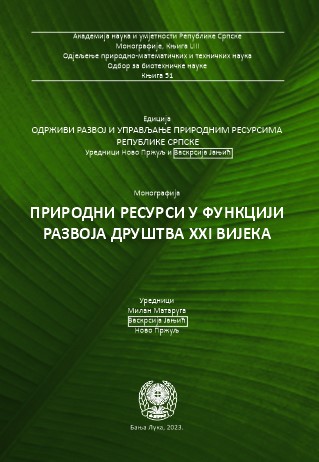Influence of demographic processes on multifunctional use of natural resources
DOI:
https://doi.org/10.7251/EORU2307299MKeywords:
demographic processes, natural resources, economic growth, arable soil, fresh water, urbanization, depopulation, the Republic of SrpskaAbstract
It is on a daily basis that modern humankind encounters a challenge to provide basic resources for living. Population growth leads to the emerging need to use natural resources (fresh water, oil, natural gas, coal, arable soil, etc.). The supplies and use of these resources are a persistent problem. As the process of urbanization intensifies, the awareness of the limitations of specific commercially overused resources rises. These processes are tightly connected with environment impairment and sustainable development. New technologies do increase productivity but the ratio of labor force and job positions decreases, raising an issue of future working population. Population and human resources have a multidimensional impact on economic growth of each country, which also includes continuous use of natural resources. A balanced population distribution is one of the crucial factors of functional sustainability of space, natural resource use, and social prosperity. It is in late 2020 that our planet marks the population of slightly less than eight billion and the figures will grow up to 10 billion in 2050. Changes in the structure and number of population affect many aspects of our lives. It is of an utmost pertinence to understand modern demographic processes in order to meet many challenges regarding natural resource use as these challenges are directly connected with fresh water shortage, hunger and underfeeding, climate change, diseases, economic growth, energetics shortage, clashes and wars. Even though natural resources play an important role, it is the human resources that matter the most. The specificity and exceptionality of human resources make them more relevant than other resources and they are extremely pertinent for the economic growth of any given area. Investing in human resources is more effective than investing in any other resource because of the ability of self-renewal and growth. In addition, human resources may employ all their mental, physical, and other available potentials. Hence, special attention should be paid to demographic processes and other changes taking place in regard to population. The fast scientific-technological revolution transformed the relation between demographic processes and natural resources, i.e. natural resource management. Centralization and the introduction of the so-called agribusiness market approach based on new economic models resulted in massive increase of productivity and efficiency in natural resource use, which successfully met the needs of the growing population but also led to wealth accumulation. Nevertheless, the same process caused the vast decrease and degradation of arable soil and forests, over-usage of natural resources, and irreversible destruction of habitats. Humankind gradually entered into a vicious circle of demographic growth, urbanization, increased food demands and requests for natural resources on one side and the increasing degradation of these resources on the other side. Unsustainability of natural resource management based solely on agribusiness market principles (supranational or global framework, accumulation of private property or corporate wealth) is becoming more evident. The Republic of Srpska is currently employed in the final phase of demographic transition, which is conditioned by poor economic growth and tertiarization, inadequate use of natural resources, and favorable transportation-geographical position, which has already initiated biological disturbances. Given the population density and distribution, the Republic of Srpska is an extremely homogeneous area with pronounced regional and interregional disparities. One such unbalanced spatial population distribution has negative effects on natural resource use and the total socio-economic growth. Most areas are affected by depopulation. The situation is most alarming in undersized and mountain settlements and areas along the entity borderline. The negative demographic conditions are further complicated by the negative migration balance so a large-scale depopulation becomes an emerging problem. Negative demographic features resulting from the current socio-economic situation, historical factors, and geopolitical issues from the 1990s are typical of the Republic of Srpska. All these determinants clearly indicate the unbalanced concentration and the decrease in the number of population. Early 21st century is demographically challenging for the Republic of Srpska as the number of population decreases and birth rates are negative. We may infer that demographic resources of the Republic of Srpska are humble and insufficient in regard to potential use of main natural resources (arable soil, forests, hydropotential, and mineral ore). The renewal of demographic resources depends on the constantly decreasing birth rates and, unfortunately, increasing mortality rates. If we add negative tendencies of intensive population aging and emigration, we may infer that the future use of natural resources shall be a great challenge to the economic growth of the Republic of Srpska. Hence, a question remains how to most optimally use natural and demographic resources in order to achieve a more balanced socio-economic growth in the Republic of Srpska.
